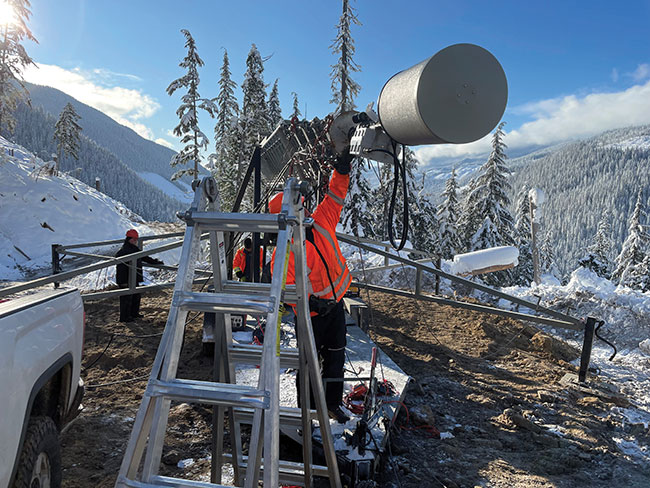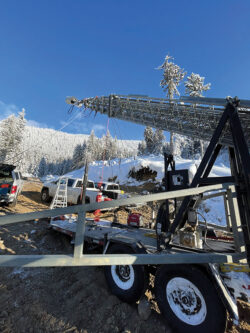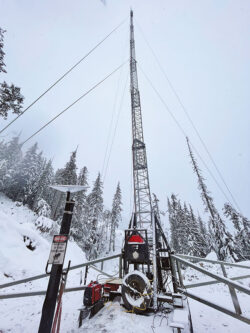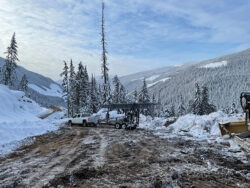
Features
In-forest connectivity
Digital transformation and enhanced safety in forest operations
May 9, 2023 By Mithun Shetty
 A 100-ft. tower deployed in Tolko’s Sugar Lake operation. Photos courtesy of FPInnovations.
A 100-ft. tower deployed in Tolko’s Sugar Lake operation. Photos courtesy of FPInnovations. History has been created in forest operations. For the first time, a worker made a phone call via portable cellular network from a remote location to office staff in town during an operational trial. With the trial’s success, now is the right time for the industry to join forces with telecom providers to scale up implementation.
Progress have been made over the past months in bringing this technology to forest operations. In the newest development, work has moved from research to implementation where Tolko Industries, an FPInnovations industry partner, has taken control of the deployment of the portable cell towers as required for autonomous deployment.
Let us revisit the need, challenges, achievements, collaborations, trial locations, applications, and scaling up strategies of this project.
Need for advanced connectivity in the forest
More than 50,000 people work in remote forests in Canada and most of these operating areas lack cell coverage. The connectivity for making calls and transferring data is limited with the use of GEO-based satellite and VHF (very high frequency) radios. Digital transformation opportunities cannot be fully realized until advanced connectivity is brought to forest operations.
Challenges in bringing connectivity

A quick deployable 30-ft. portable tower.
Forestry is unique due to its dynamic operations (moving around everyday and not coming back to the same place for 70 years), remote locations, challenging terrain, and heavy vegetation, all of which heavily influence the cell signal coverage from the tower. Locations of operations are temporary and can be easily moved beyond the coverage from a single tower, which makes portability and ease of set up key for implementation. In addition, when access to power from utilities is unavailable, the power needs to come from a portable generator, which would ideally be powered from a clean energy source.
Overcoming challenges and achievements to date
The recent introduction of high-speed internet using LEO constellations with a satellite terminal for backhaul has helped bring internet into forests in a cost-effective way. The 100-ft. tower helped transmit signals above the treeline. The use of a tower-mounted amplifier helped reduce the imbalances between the downlink and uplink coverage, and the vehicle-mounted cell boosters helped extend the coverage in the forest environment. The tower location at a high point and combinations of the above tools helped bring wide-area coverage with a radius of up to 10 km in the forested areas.
Co-operators and partners’ support
Our industry partner, Tolko, was the early adopter and pioneer of this technology. The role of Tolko, its contractors, Innovation Science Economic Development, and our technology partners in the development of this solution was crucial as we hit a few roadblocks along the project; however, with strong collaborations and teamwork we were able to overcome these roadblocks and now we have a solution that is ready for the industry to implement in its operations.
Trial locations

A 100-ft. tower deployed in Tolko’s Sugar Lake operation.
The research trials started in Tolko’s Cariboo division near Williams Lake, B.C., and has now been deployed near Sugar Lake, B.C., in Tolko’s Southern Interior division, as part of a longer-term operational trial. This area has been a challenge for communications as the VHF repeater did not provide complete coverage and resulted in areas without any cell coverage, until now. One 100-ft. and one 30-ft. portable tower were deployed in the operations. Some planning is required to find the high point for the tower location that is accessible by road and provides the required coverage for the operating area. Simple tools in Google Earth, such as viewshed and elevation profile, have proven useful for finding the appropriate locations for the tower deployment.
Applications enabled by advanced connectivity
There are limited applications that can be used for forestry operations, but now with a reliable and more cost-efficient connectivity solution, programmers will be able to develop more. Connectivity in operations will open up opportunities for improving operational safety and efficiency.
Many ideas for new apps arose during the operational trials. The most critical one would be a phone and messaging app for communication among all forest workers within the remote cellular coverage and the rest of the connected world. Other critical needs would focus on equipment diagnostics, determination of real-time locations, and transmission of machine data, which will be important for digital transformation. The list for app developments keeps growing as more users are getting used to having connectivity where it hasn’t been a reality before.
Scaling up connectivity solutions

Advanced connectivity will act as a game changer.
Telecommunications providers could offer the integrated solutions on lease to the industry; however, sending the support team for deployment in the field will make it cost prohibitive. Therefore, partnering with industry for deploying this solution will be the key. This project proved that the industry is capable of operating, moving, and maintaining the cell tower. This tower will soon be an essential tool that would be moved as the equipment moves to new locations. To scale up the connectivity solutions, the forest industry could partner with wildfire agencies and First Nations communities in remote areas to have shared portable network towers in forests.
Advanced connectivity will act as a game changer and will help to bring digital transformation and enhanced safety to forest operations. FPInnovations encourages the industry and telecom providers to work together to build the connectivity infrastructure that will bring revolution in the industry.
Mithun Shetty is a senior researcher with FPInnovations’ Transportation and Infrastructure group. He is a professional engineer registered in B.C. and has a master’s degree of applied science in forestry from UBC. He has around 20 years of experience in the transport sector with expertise in Intelligent Transportation Systems and has lead several innovation projects including in-forest connectivity project.
Print this page